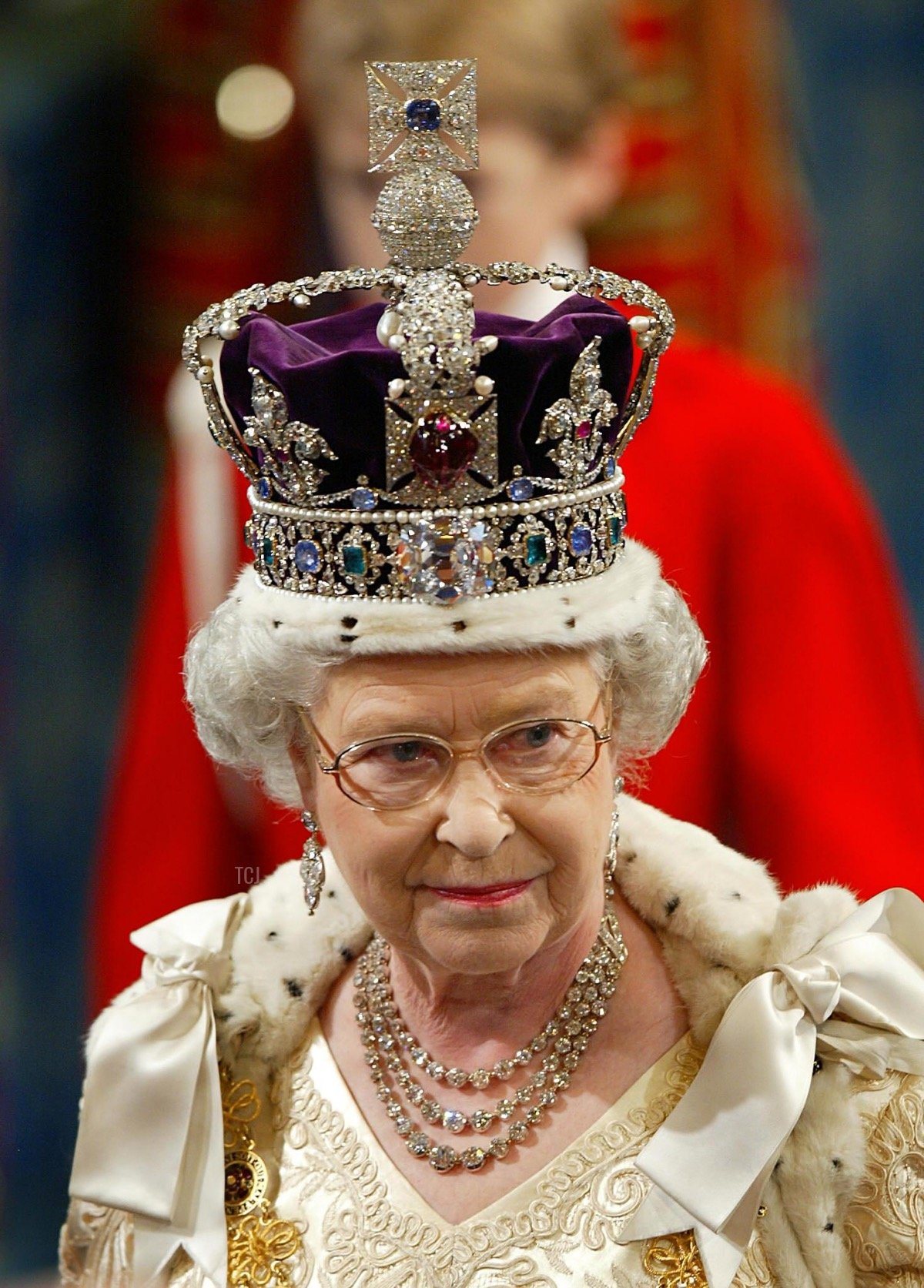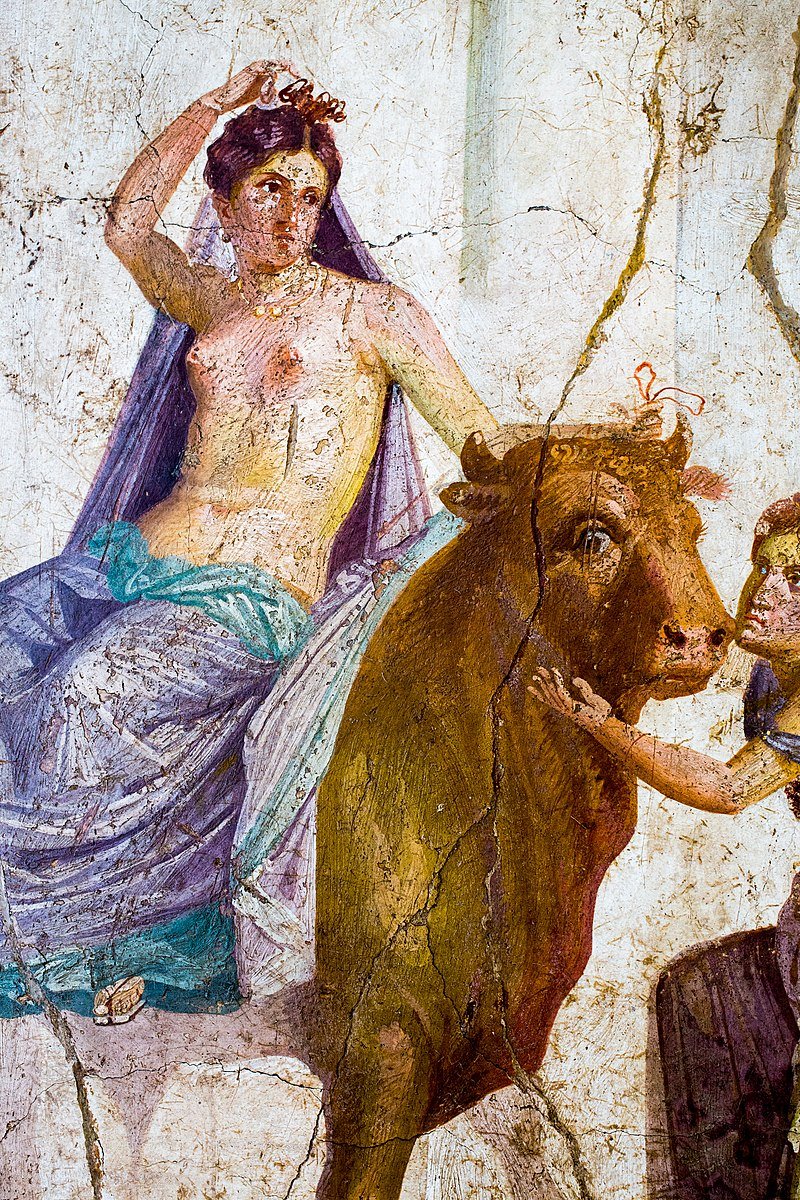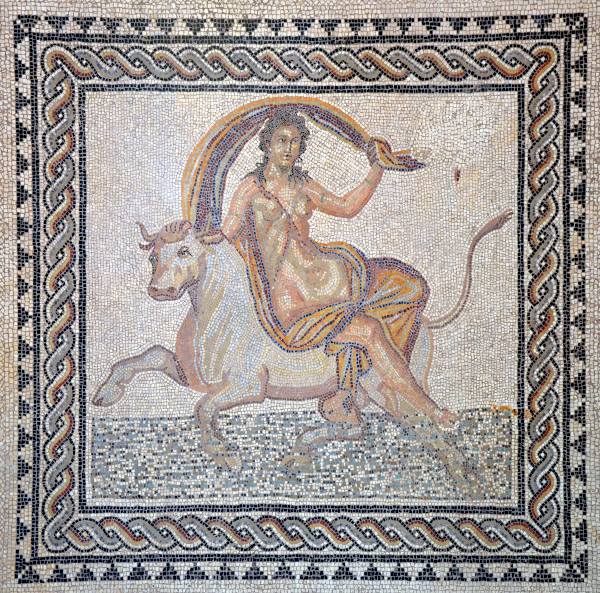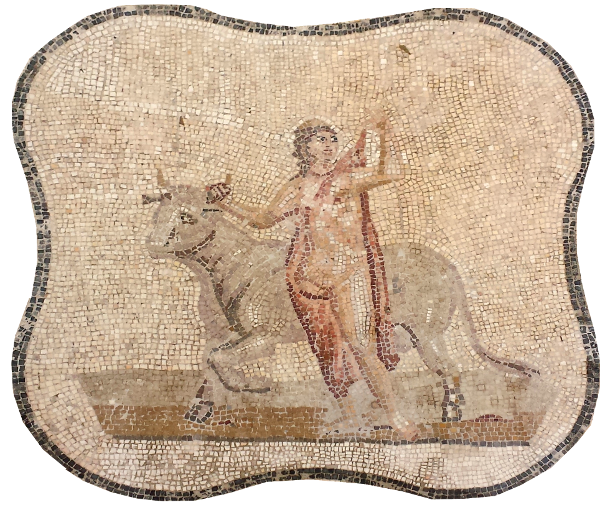On Europa's Journey: Unraveling the Myth and Lebanese Identity (William Okaily, ARP.3)
Mosaic fragment depicting Europa and the Bull from Room 1, House of the Boat of Psyches, Daphne (Antioch). ~ 3rd century CE. Cut stone tesserae and lime mortar, with mid-20th century conservation pigments. Current location: Baltimore Museum of Art 1937.129.
As part of the Antioch Recovery Project, I delve into the study of a mosaic fragment, currently housed at the Baltimore Museum of Art. Through the study of the Europa and the Bull myth portrayed in this piece, I hope to present a distinct lens through which we can view both the ancient world and its echoes in contemporary times, with a special emphasis on its significance for Lebanon. My exploration revolves around understanding the mosaic's relevance in the context of its creation in the 3rd century and its continued resonance today. This journey is not just a historical one; it is also an inquiry into the evolving nature of mythology and its impact on cultural and national identity. In the realm of myths, there are no singular truths or definitive versions. These narratives are shaped and reshaped by the cultures that adopt them, each rendition reflecting the diverse perspectives and historical contexts of its time. In this study, I embrace the multifaceted nature of the Europa myth. Rather than attempting to categorize or seek an 'actual' version, I explore the various stories that have emerged across different cultures and periods. Myths, in their diversity, offer a tapestry of insights and meanings, each as valid as the next.
This analysis of the Europa myth is conducted through a non-linear thematic approach, emphasizing the interconnectedness of themes and ideas. Such a structure allows for a holistic exploration of motifs that transcend temporal and geographical boundaries, highlighting the enduring relevance of the story of Europa in a contemporary context. I will start by traversing through the cultural intersections of the Greco-Roman-Phoenician world, delving into the linguistic legacy of the Phoenician alphabet, then navigating the symbolic significance of water and the Mediterranean, to finally connect the ancient myth to contemporary Lebanon.
The Cultural Tapestry of the Graeco-Roman-Phoenician World: The Historic and Symbolic Significance of the Myth at the Time
In discussing the myth of Europa, it becomes apparent that the delineation between the Graeco-Roman and Phoenician worlds is not as distinct as often portrayed. A more accurate depiction might be a Graeco-Roman-Phoenician sphere, where each empire's culture permeates the others during their expansions around the Mediterranean Sea. This amalgamation is evident in their shared myths, deities, and cultural practices, albeit with variations in names, events, and locales.
Map of the Phoenician world marking trade route. https://www.thecollector.com/trade-in-ancient-phoenicia/
The Greeks, Romans, and Phoenicians preserved local cultures, rites, and traditions upon their expansion. Conquering new territories often led to cultural exchanges rather than explicit erasure. The conquerors allowed local beliefs to persist, which in turn influenced their own mythologies and practices. This reciprocal relationship fostered an intertwined tapestry of shared myths and legends, making it difficult to track what bit of the modern narrative came from where.
Variations of the Europa Myth
The myth of Europa, central here to our analysis, exemplifies this cultural blend. Originating from Phoenician coastal cities like Byblos, Tyre, or Sidon, Europa's story varies in its details. Whether Zeus, disguised as a Bull, flew or walked through the Mediterranean Sea, or whether Europa was the daughter of Agenor or Phoenix or the King of Byblos, the consistent elements across these narratives are her Phoenician identity, her brother, Cadmus, and the crossing of the Mediterranean. These variations highlight the fluid nature of myths across these intertwined civilizations.
The Europa myth, as elucidated by Herodotus in The Histories, reveals deeper geopolitical connotations. Originally, it might have symbolized the rivalry between Greece and Troy, later extending to the Greeks and Persians, thus embodying the tension between civilizations around the Mediterranean. It could also depict an early Hellenic invasion of Crete or a raid on Phoenicia by Hellenes from Crete, reflecting a common theme of abducting enemy princesses—a practice seen in the stories of Io, Medea, and Helen, alongside Europa.
(Herodotus, The Histories, translated by A. de Sélincourt. Harmondsworth, revised edition 1972, p. 42, who explains the Europa myth in the context of woman-stealing being quite a normal practice at the time.)
Europa, often considered a demi-goddess, hence a figure of nobility, represents more than a mythological character; she embodies the spirit of travel, commerce, and cultural exchange that defined the Phoenician, Greek, and Roman empires. Her journey across the Mediterranean, from Phoenician roots to Greek shores, can be seen as a metaphor for the expansion and influence of these ancient civilizations on one another. This myth is often seen as a union between the East and the West, or that Europe came from Asia. I consider the possibility of reading this myth as the expansion of Europe from the Phoenician coast toward the west of the Mediterranean. This manifold of interpretations speaks to the evolving geography and definition of Europe which is still a prevalent issue in contemporary political discourse.
The Phoenician Alphabet as a Cultural Legacy
In a version of the Europa myth that I was taught in Lebanon, the story emphasizes a deep cultural and linguistic significance. This narrative posits that Cadmus, Europa's brother, had hidden the Phoenician alphabet in Europa's dress. Upon her abduction to Crete by Zeus, Europa shared this phonetic alphabet with her new home, thereby catalyzing a significant cross-cultural exchange.
Europa's journey from Phoenicia to Crete is emblematic of more than a mythic tale; it signifies the transfer of the phonetic alphabet, a paradigm shift in the evolution of the written word. The Phoenician alphabet, known for its efficiency and influence, is depicted as the precursor to the Greek and subsequently Latin alphabets, highlighting its pivotal role in the evolution of written communication in the Mediterranean region.
The myth continues with Cadmus's odyssey to find his sister. His quest leads him to establish the city of Thebes in Greece, where he introduces the Phoenician alphabet. This act symbolizes the dissemination of this critical script from its Phoenician roots to the wider Greek world, weaving together the cultural fabric of these ancient civilizations.
Coin found at Tyre. Gallienus. 253-268 CE. O: Laureate, draped, and cuirassed bust right R: Cadmus (left) presenting the alphabet on a rolled papyrus to four men; murex shell at Cadmus’ feet, ΕΛΛH/ and KA/ in exergue. Source: Classical Numistmatic Group
Zeus's transformation into a bull in this myth carries layered symbolism. Representing divine power and wisdom as the supreme god, the bull also alludes to the Aleph – the first letter of the Phoenician alphabet. This connection, through the bull's representation inspired by the animal’s head and horns, links the genesis of the alphabet to the divine realm.
The Phoenician alphabet. Image source: Phoenicians in Phoenicia.
Europa's tale of bringing the phonetic written language to Crete mirrors the cultural and intellectual amalgamation evident in Antioch. This ancient hub, where Greek, Roman, and Phoenician cultures converged, thrived on the fusion of ideas, technologies, and languages. Europa's story, as learned in Lebanon, specifically encapsulates this dynamic of cultural and intellectual interplay.
Water, the Mediterranean, and Cultural Currents
The mosaic fragment I am studying, originating from a house researchers named "House of the Boat of Psyches", significantly features water as a recurrent theme. This emphasis on aquatic elements is not just decorative but deeply symbolic, reflecting the vital role of water in the ancient Mediterranean world.
Reconstruction of the mosaic fragments from the House of the Boat of Psyches. Source: Kondoleon 2000.
All the cities mentioned in the Europa myth, including the starting point of the story in Lebanon, are situated along the Mediterranean Sea. This sea, more than a geographical feature, acted as a connector for cultures and stories. The journey of the Europa myth, mirroring the flow of the Orontes River from the Bekaa in Lebanon to Antioch, symbolizes the transmission of cultural narratives along waterways.
Intriguingly, the mosaic fragment depicting Europa and the bull is situated adjacent to another mosaic of Tethys and Oceanus in the same room. A connection between these figures is flagrant, as one of Tethys and Oceanus' daughters is also named Europa. This overlapping of names and themes underscores the intertextuality of mythological narratives in the ancient Mediterranean.
Mosaic fragment depicting Tethys and Oceanus, framed by a border of geometric patterns, birds, and plants from Room 1, House of the Boat of Psyches. Daphne (Antioch), 3rd century CE. Current location: Baltimore Museum of Art 1937.126
Some versions of the myth tie Europa to Poseidon, further cementing the relationship between the myth and the maritime world. The depiction of Nereids, sometimes shown riding sea creatures resembling bulls with aquatic tails, parallels Europa's representations journeying across the sea. These renditions highlight the symbolic and literal importance of water in these ancient stories.
Fragments of a Hanging with Two Nereids. 5th-6th centuries CE. Current Location: Dumbarton Oaks BZ.1932.1
The significance of water extends beyond mythology into the everyday lives and religious practices of the Phoenicians and Lebanese. The transformation of Phoenician temples into Christian churches in Lebanon is a powerful testament to this enduring maritime connection. A prime example is the church in Batroun, known as "Our Lady of the Sea". This church, originally a Phoenician temple, reflects the seamless integration of ancient maritime reverence into Christian worship. Such transformations illustrate a cultural continuity, where the sea remains a central element of spiritual life. Furthermore, the Phoenician name 'Maryam' (Mar-Yam), translating to 'Lady of the Sea', exemplifies the fusion of cultural and religious identities. In Phoenician tradition, 'Mar' signifies a goddess or lady, and 'Yam' means sea. This nomenclature indicates the Phoenicians' deep reverence for the sea as a divine entity. In Christian tradition, this reverence is mirrored in the veneration of the Virgin Mary. In Lebanon, Orthodox and Maronite icons depicting the Virgin Mary with a fish tail symbolize this blend of ancient maritime worship with Christian theology. The Virgin Mary of Jbeil (Byblos) and Batroun, referred to as "Our Lady of the Sea", continues to be a significant figure in Lebanese culture. These sites, which were once centers of Phoenician worship, have transitioned into Christian places of reverence, yet they retain their connection to the sea. This enduring symbol acts as a bridge between the ancient Phoenician civilization and modern Lebanon, reflecting a continuous cultural and spiritual bond with the Mediterranean. It is important to add that the Maronite Patriarch, who is Lebanese and based in Bkerké, bears the title "Patriarch of Antioch and All the East." This title signifies the enduring religious and cultural connections between Lebanon and Antioch, further emphasizing Lebanon's integral role in the tapestry of Eastern and Mediterranean Christian traditions.
Icon of Mary with a fish tail
Bridging the Europa Myth and Contemporary Lebanon
The myth of Europa, along with her brother Cadmus, has left an indelible mark on the history and culture of Europe. Cadmus, credited with bringing the Phoenician alphabet to Greece, laid the foundation for the development of Western script. Europa's story, preserved through centuries of oral tradition, continues to symbolize cultural exchange and influence between Lebanon and Europe.
The legacy of Phoenician commerce, epitomized by the renowned Tyrian Purple, still resonates today, adorning the robes of religious and royal figures like the Pope and the British Royal Family. Although the specific mosaic fragment I study does not depict Europa in Tyrian Purple, many artistic representations do, reflecting the historical significance of this dye in ancient commerce and culture.
Images of Pope Francis in cloak (left) and Queen Elisabeth II wearing the royal crown (right) both of a Tyrian Purple color
Depictions in painting and mosaic of Europa holding or wearing a Tyrian purple cloth.
Lebanon's historical connections with Europe are profound. For instance, the name 'Britain' is believed to derive from 'Baratanac', a term used by Phoenician sailors to describe islands adjacent to Britain who were rich in tin ('bara' meaning land and 'tanac' meaning tin). This linguistic footprint underscores the deep-rooted interactions between the Phoenicians and early European civilizations.
In today's Lebanon, the discussion of identity is complex and multifaceted. The shift from Lebanon being described as "a country with an Arab face" pre-Taef Accord to having "an Arab identity" post-Taef Accord in the constitution reflects ongoing debates about the nation's cultural and historical identity. These discussions are intertwined with Lebanon's rich Phoenician heritage and its ties to the Mediterranean and European cultures.
The history of the Phoenicians as both intrepid explorers and devoted patriots resonates with the contemporary Lebanese experience. Their openness to cultural exchange, exemplified by their adoption of the Greek alphabet with vowels, could reflect a tradition of embracing and integrating new ideas for progress. This historical perspective raises poignant questions for modern Lebanon: How should the nation write its history, and what distinct identity should it claim amidst a legacy of cultural synthesis and exchange?
The Europa myth, with its themes of journey, transformation, and cultural exchange, mirrors Lebanon's ongoing narrative as a country at the crossroads of civilizations. It challenges modern Lebanese society to embrace its multifaceted heritage, drawing strength from its historical roots while forging a distinct and dynamic identity in the contemporary world.
—William Okaily
Cite as: Okaily, William. “On Europa's Journey: Unraveling the Myth and Lebanese Identity (William Okaily, ARP.3)” Antioch Recovery Project (Blog). https://www.antiochrecoveryproject.org/mosaics/on-europas-journey-unraveling-the-myth-and-lebanese-identity-william-okaily-arp3














